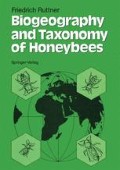Abstract
The Dwarf Honeybee has found its ecological niche in the stratum of dense bushes and small trees of the tropics. This biotope requires small nests and small body size, and special adaptations for survival. A. florea is the most peculiar Apis species in several ways (Free 1981). Generally it is regarded as a species on a relatively low phylogenetic level within the genus. In several characteristics, however, it is certainly a very differentiated species, remote from the general line of evolution observed in the other Apis species.
Access this chapter
Tax calculation will be finalised at checkout
Purchases are for personal use only
Preview
Unable to display preview. Download preview PDF.
Author information
Authors and Affiliations
Rights and permissions
Copyright information
© 1988 Springer-Verlag Berlin Heidelberg
About this chapter
Cite this chapter
Ruttner, F. (1988). Apis florea Fabricius 1787:305. In: Biogeography and Taxonomy of Honeybees. Springer, Berlin, Heidelberg. https://doi.org/10.1007/978-3-642-72649-1_7
Download citation
DOI: https://doi.org/10.1007/978-3-642-72649-1_7
Publisher Name: Springer, Berlin, Heidelberg
Print ISBN: 978-3-642-72651-4
Online ISBN: 978-3-642-72649-1
eBook Packages: Springer Book Archive

